Anyone who works in library communications and marketing is used to wearing many hats, some that we have formal training for and others that we are thrust into wearing. Being able to adapt to change is key. In my time in federal and public libraries and in the nonprofit arts sector, I have experienced several different models for organizing programming, marketing and communications, and outreach, and most of them separate these functional areas under different senior leaders.
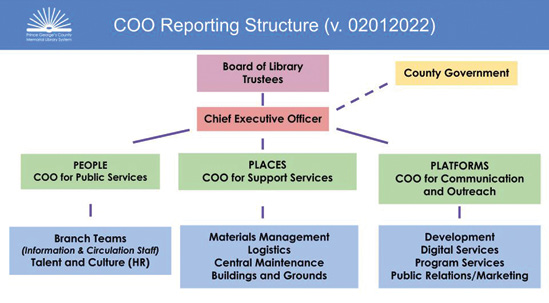 This organizational chart shows the foundation of PGCMLS’s COO reporting structure. This organizational chart shows the foundation of PGCMLS’s COO reporting structure. |
In federal libraries, I worked in subject area programming, outreach, and communications, and I would constantly get frustrated when the formal and very well-staffed office of communications’ priorities did not match our division’s priorities. In a small arts nonprofit where everything should be integrated, I experienced how marketing resources are allocated according to revenue priorities. The makeup of public library marketing teams runs the gamut, from small teams with no dedicated subject experts to bureaucratic institutions with large, siloed departments.
At the Prince George’s County Memorial Library System (PGCMLS) in Maryland, where I serve as the COO for communication and outreach, the current organizational structure integrates communications, marketing, digital services, programs, outreach, fundraising, and government relations (which I will collectively call “external engagement” for brevity’s sake). This is a hugely beneficial model, especially for historically underfunded and understaffed libraries, as cross-functional collaboration can maximize impact and nurture creativity.
During the COVID-19 pandemic, my team would not have been nearly as successful with maintaining connections with customers without this integrated approach to external engagement. In this article, I’ll explain this unusual organizational setup, along with how and why it works, and end with why I highly recommend it.
People, Places, and Platforms
PGCMLS’s CEO, Roberta Phillips, assumed her role in 2019. Within 6 months, she began to implement her vision for the library’s structure, which focuses on three pillars:
- People (branch teams and public services)
- Places (facilities and support services)
- Platforms (engagement with customers, partners, and stakeholders)
Prior to Phillips’ arrival, PGCMLS was organized into two divisions—public services and support services. Central oversight of programs and outreach was under the COO for public services, while communications and digital services were led by the COO for support services. (COO roles at PGCMLS are equivalent to deputy director roles in other libraries.)
Because both of these COOs maintained large portfolios, there was a very decentralized approach to programming, outreach, and communication strategy. Phillips envisioned a third division, communication and outreach, that would integrate and elevate the importance of institutional strategy for partnerships, fundraising, communicating with customers, and engaging with stakeholder groups.

This graphic from a 2021 LGBTQ+ pride (“orgullo”) campaign for Spanish speakers illustrates how PGCMLS strategically embraces diversity and demonstrates its inclusivity. |
Adding a third COO to oversee communication and outreach was a key step forward for implementing Phillips’ vision for the library. The new division was originally composed of five small departments (development, public relations/marketing, digital services, program services, and intercultural services) that employed up to 16 staff members. Then, program and outreach development were formally intertwined at a strategic level in an effort to engage strategic partners, to leverage digital platforms to increase access, and to take advantage of philanthropic support to expand offerings.
PGCMLS’s current vision for external engagement has a clear aim. According to its vision statement, we support the library’s work to provide a “collaborative foundation within the community for all Prince Georgians to create the world they want to see.” This vision is expressed as we realize our core function: to provide open access to trustworthy information resources. The communication and outreach team dedicates itself to creating opportunities for customers, influencers, and stakeholders to learn the value of the library in advancing the community, whether through Instagram stories, book discussion events, cultural heritage awareness campaigns, or headliner author events.
Interdisciplinary Best Practices
I believe library marketing and communication teams are most effective when they embrace interdisciplinary approaches to achieving and sustaining engagement with customers. We have to understand effective marketing strategies across industries, including retail, ecommerce, entertainment, and multinational corporations, as well as the neighborhood lemonade stand.
The best marketing, no matter the era or industry, leverages modes of expression and engagement that resonate with target constituencies’ behavior patterns and interests. And that is the case here. Of the 15 current communication and outreach team members, only two of us hold library degrees. Only one person holds a degree in communications. Our team collectively includes educators, web developers, graphic designers, social entrepreneurs, music producers, an adult education expert, and a former English Language Learner instructor. We bring expertise from various industries to a public library setting, which gives us a different perspective than colleagues who assume communications duties and have only ever worked in libraries. I acquired on-the-job communication training through my work as a musician and music producer and as an intern at the Boston Symphony Orchestra’s press office during college.
Effective marketing and communication strategies will always differ among various historical moments and local contexts, but the most successful efforts are always the ones that are memorable, have a clear intent, and provoke an emotional response. Storytelling is at the heart of effective marketing and communications, whether you are pitching a story to local media, posting yet another operations change on social media, or seeking funding from a private donor. It is our responsibility to tell the story of our libraries in new ways to meet changing customer needs.
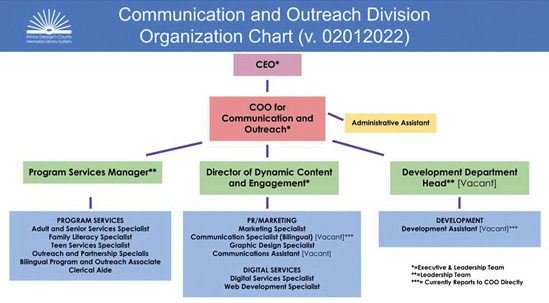
This detailed chart shows how departments are organized under the author’s new communication and outreach division. |
Throughout my career, I have embraced disrupting the status quo with external engagement. This is the only way to make a splash, interest new customers, and build long-term engagement. Here are some examples. As a music specialist at the Library of Congress, one of my focus areas was bringing more Millennial concertgoers to the very established and connoisseur-focused classical and jazz concert series. I also produced a groundbreaking series called Library of Congress Bibliodiscotheque that resulted in the library’s highest earned media reach for a project to date (135 million-plus with no marketing budget). At Washington Performing Arts, I engaged schools, the DC Public Library, the Goethe-Institut, Union Station, and the Library of Congress to give greater relevance to community arts programming. I have also proactively engaged local personalities as influencers to help strategically amplify library projects to their followers. The lessons learned during past professional experiences are all at the table when my team and I lead integrated external engagement at PGCMLS.
I’ll share a great example of leveraging influencer marketing (a strategy widely used by businesses and community organizers) to grow audiences for library programs. PGCMLS maintains a relationship with bookstagrammer and author Jamise Harper (@SpinesVines on Instagram, founder of #DiverseSpines on social media, and co-author of Bibliophile: Diverse Spines). Harper, who has 26,000 Instagram followers, has interviewed authors like Bassey Ikpi on our virtual event series and has appeared to discuss her own book.
These examples have shown me that beneficial partnerships, deep community visibility, staff creativity, and strategic earned media coverage are the best paths to overcome funding limitations. PGCMLS has a woefully small communications and marketing budget for a large library system—just $42,900 in FY 2022 (including printing, advertising, and special events, but excluding staffing costs). That’s a whopping .128% of the library’s annual budget. Clearly, we would not reach any customers if we depended entirely on paid marketing. To make up for that financial shortfall, we seek to engage programmatic, outreach, and promotional partners as much as possible to help us reach their followers, especially when they regularly engage with customers we are not reaching.
How the New Division Operates
The communication and outreach division at PGCMLS is currently composed of four departments: program services, public relations and marketing, digital services, and development. We previously had a fifth department, intercultural services, which has been combined into the program section to ensure that immigrant and English Language Learner services are part of a systemwide program and outreach strategy.
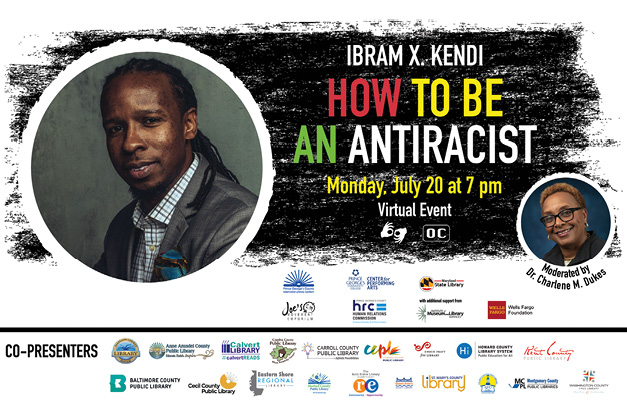
This Ibram X. Kendi promotional graphic, from July 2020, displays the large network of partners that co-presented the event. |
The Team: We currently have 18 positions on the team, although a few are currently vacant, as you can see on the organizational chart on page 3.
Even with this solid organizational model, we need to remain nimble. As the chart shows, the digital services manager was upgraded (due to COVID-19-related operations needs) to the role of director of dynamic content and engagement, co-leading the public relations and marketing department with me and directly managing the digital services department.
As COO for communication and outreach, I am the primary liaison between the library and the PGCMLS Foundation. Because so many areas fall under one senior executive, I am able to clear barriers between departments within the division, and I’m also able to advocate for our priorities at a systemwide level.
The Workflow: The program services department oversees programming and outreach strategy in accordance with our Strategic Framework 2021–2024 focus areas: inclusion, literacy and learning, healthy living, personal achievement, and creativity. In this setup, staff members throughout the library are able to develop and submit programs for review by the program services team, whose role it is to ensure that we have balanced offerings based on library and community priorities.
Since the start of the COVID-19 pandemic, our program services team has worked closely with the digital services team to establish (and regularly update) virtual programming procedures and guidelines. As operations have constantly shifted throughout the pandemic, the collaborative effort within the communication and outreach division has been key to providing clear guidance to staffers who develop programs and outreach throughout the system. Branch staffers handle the majority of programming and outreach, whereas program services staff coordinate procedures, settle on strategy, and select major systemwide initiatives.
We strive to support the needs of internal customers and branch workers by giving them access to standardized resources, like Canva templates for branch-level fliers. This frees our colleagues from having to come to the overstretched public relations and marketing team for every single collateral item they might need.
The Tools: My team is always in search of ways to refine and adapt workflows to increase efficiency. We already used the Google suite of products prior to the pandemic, and that helped us smoothly transition into more constant collaborative digital work when we switched to telework.
In 2020, the digital services department launched a new intranet called Connect, which uses a cloud-based platform called Interact. The previous intranet was wiki-based and only accessible on the library’s closed network, which was inaccessible to most employees, even when they were temporarily equipped and authorized for telework during the first year of the pandemic.
When everyone’s email inboxes were getting out of hand, we acquired a Trello license to manage tasks, assignments, and routing. (Trello also provides handy reminders and accountability checks for the whole team.) The public relations and marketing and the digital services departments were the first to adopt Trello for workflow tracking. Cutting down on project routing through email immediately added capacity for design and production. Spanish translation workflows and program planning were also integrated into Trello in late 2021.
Tactical Motto: ‘Tenacity Begets Victory’
What could a former army bandsman possibly know about library marketing? The answer might surprise you.
As I began to pursue a career in the military, one of my cadet leaders, Patrick Corcoran, established a corps motto that is entirely applicable to library marketing and communications: “Tenacity begets victory.” That phrase fits this work. In a partnership-driven approach to promoting library programs and services, we are often faced with circumstances in which we have to be persistent and embrace tenacity to advance partnerships in the face of bureaucracy, institutional norms, and funding limitations.
My colleagues have been tenacious. When PGCMLS announced its closure because of COVID-19 in early March 2020, less than 8 weeks into my tenure at the library, my team was confronted with the great unknown. We had to find a way to sustain the amazing relationships our branch teams had with customers—but now, in a virtual environment. We had zero existing infrastructure for virtual programs, a lackluster social media presence, and limited telework preparedness (both with policy and equipment).
COVID Forces Events and Campaigns Online
My full team quickly started doing two things: 1) figuring out a way to produce live virtual programs from home with basic webcams and 2) experimenting with new marketing campaigns to promote online resources and drive-up Wi-Fi. Because the communication and outreach division had been established just a few weeks earlier, the team members clearly understood that they had to work across departmental lines. Cooperation would be essential to success.
Fortunately, our digital services team rose to the occasion, and together, we learned to broadcast from home. PGCMLS’s CEO and area managers, along with my team members, led most of our in-house virtual programs for the first 6 weeks of the pandemic.
To stay connected with existing customers, we immediately increased our use of email marketing. Unfortunately, that did not really address the need to reach the more than 500,000 other county residents (roughly 54%) who were not on our email list.
So we ramped up our social media accounts. Since January 2020, when I started at PGCMLS, our following has grown by leaps and bounds:
- Facebook +123%
- Instagram +222%
- Twitter +66%
- YouTube +8,950%
The increases are attributed to our efforts to build online engagement during COVID-19, with key virtual programs driving rapid increases. We also added new platforms to our portfolio: Discord, TikTok, Clubhouse, and LinkedIn.
Communication and Cross-Promotion
Next, we turned to partners, many of whom I was able to connect with through the county’s Joint Information Center (JIC), the group of agency public information officers who are responsible for emergency communications during crises like the pandemic. Members of agencies, such as our county and municipal police departments and the department of the environment, and the State’s Attorney for Prince George’s County, Aisha N. Braveboy, participated in live virtual programs for children and families, while our branch staff (who typically cover the majority of programs) were on administrative leave and not yet teleworking.
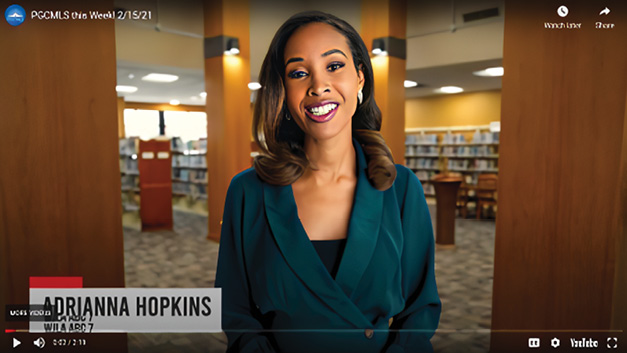
A screenshot from a recent episode of PGCMLS This Week, which Adriana Hopkins of 7News DC tapes at the library. View past episodes at youtube.com/pgcmls. |
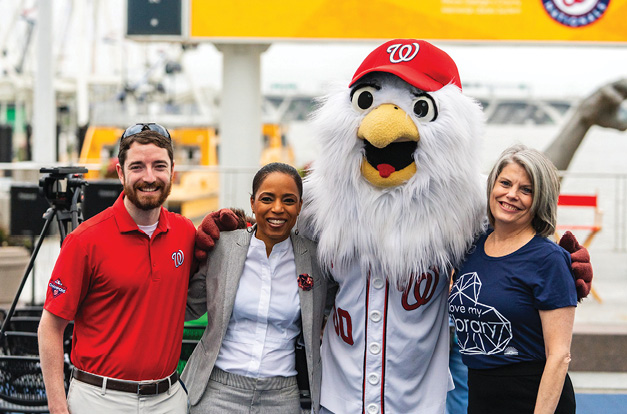
Sports highlight (L to R): Washington Nationals director of community relations Alex Robbins, Prince George’s County Executive Angela D. Alsobrooks,
team mascot Screech, and PGCMLS CEO Roberta Phillips pose at the 2021 Summer @ Your Library Kickoff at National Harbor in Oxon Hill, Maryland. |
As we settled into the pandemic programming and communications environment, we resumed programs with key partner organizations, like the Prince George’s County Office of Human Rights and the Financial Empowerment Center at Prince George’s Community College, in the virtual environment. Our partners collectively amplified what we were offering because they were involved and had a stake in our work. This is the epitome of grassroots community organizing, which embraces the strength of word-of-mouth advertising.
In addition to cross-promoting educational content, we partnered with public health officials and Prince George’s County Health Connect to promote emergency enrollment for affordable healthcare, which resulted in more than 66% of eligible county residents enrolling in healthcare coverage through the state exchange.
As the pandemic wore on, partnership-driven programming and engagement at PGCMLS expanded to the state and national level. Through Maryland State Library, we teamed up with more than 20 other public libraries in the state, plus local county partners, to present a timely virtual program in July 2020 with Ibram X. Kendi (author of How to Be an Antiracist ) during the height of the Black Lives Matter protests around the world. We reached more than 226,000 live viewers (and another 122,000-plus on demand), making the event likely the most viral public library virtual program during the first year of the pandemic.
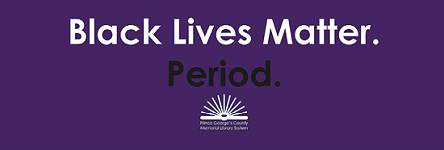
This graphic is from the “Black Lives Matter. Period.” campaign, which has been part of PCGMLS’s anti-racism communications and programs since spring 2020. |
Yet again, we achieved this viewership because partners helped spread the word to their customers, plus we used minimal paid advertising ($500 in social media ads). Our programming was paired with a bold communication campaign that made the library’s support of the Black Lives Matter movement clear as an expression of the commitment to inclusion and social justice emphasized in PGCMLS’s Strategic Framework 2021–2024.
Nationally, my team continued to grow PGCMLS’s impact and reach by partnering on cultural heritage-focused programs with the Black Caucus of the American Library Association and REFORMA. Our strategic partnerships included those with Loyalty Bookstores, which supported event book sales and more, and Capital One, which sponsored financial literacy classes for Spanish speakers and older adults and more.
All of these programmatic efforts received robust digital promotion and earned media coverage for PGCMLS. Through my work with the JIC, library initiatives began to be regularly promoted through the social media and email newsletters of County Executive Angela D. Alsobrooks. We also attracted in-kind support from 7News DC anchor Adrianna Hopkins, who tapes PGCMLS This Week , a weekly video segment to promote the library’s offerings (produced by our in-house marketing specialist).
Major Visibility via Major League Sports
There is yet another angle that the new communication and outreach division established during the pandemic: partnerships with professional sports teams. The Washington Nationals baseball team became presenting partners of our Summer @ Your Library program, and its staff even invited us to co-present Josh Bell’s Book Club, a virtual monthly book club for adults with first baseman Josh Bell that focuses on self-empowerment. This collaboration led to PGCMLS benefiting from in-kind promotion exposure on the Nationals’ TV and radio broadcasts and on jumbo screens at Nationals Park throughout the 2020 and 2021 baseball seasons.
In other sports news, PGCMLS is an inaugural co-presenter of the Washington Wizards (basketball team) Winter Reading Challenge. In fact, my team built the back end of the challenge on Beanstack so the DC Public Library and the Alexandria Library in Virginia could easily participate, making it the first-ever tristate reading challenge in the metropolitan Washington, D.C., region. In addition, the recently renamed NFL team, the Washington Commanders, is a funding partner of the library’s digital equity programs.
Also, D.C. United, the local Major League Soccer team, collaborated with our team to provide virtual educational and fitness content in English and Spanish at the very outset of the pandemic, tapping into the large soccer following in Prince George’s County (the population is 19.5% Hispanic and 22% immigrant, according to the 2020 U.S. census).
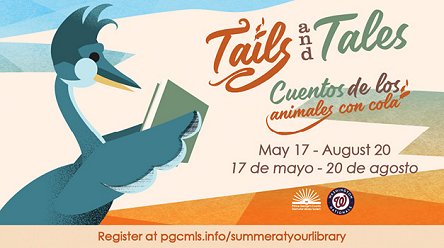
The Washington Nationals baseball team partnered to support the Summer @ Your Library program in 2021, so its logo appeared on the promo materials. |
These sports partnerships provided obvious ways for us to get the library’s name and programs in front of potential new customers, even beyond the borders of our county (any Washington, D.C.; Maryland; or Virginia resident is eligible to hold a PGCMLS card). The earned media result of these partnerships was staggering—the library achieved visibility through MLB.com, NBA.com, NFL.com, our local Spanish-language sports radio station (El Zol Deportes), and ESPN.com, among others.
Savvy About Stakeholders
Regularly engaging stakeholder groups, beyond community partners, has been an additional element of my team’s success. We collaborate regularly with the board of library trustees’ community engagement committee, the PGCMLS Foundation’s board of directors, and branches’ Friends groups to refine our messaging, clarify our priorities, and ensure that our extended community understands and supports the library’s mandate, both in daily operations and from a funding standpoint.
We have also exponentially elevated our advocacy efforts in several ways:
- Coordinating strategy with the board of library trustees
- Tracking engagement with local, state, and federal elected officials
- Directly seeking staff and customer engagement in advocacy campaigns
We now maintain a public landing page (pgcmls.info/activate) where anyone in our extended community can learn about and advance advocacy priorities at the local, state, and national levels. In addition to routine customer email marketing, we also provide biweekly updates to the PGCMLS Foundation and branch Friends groups, which helps keep them informed of our work and how their support is making a difference.
The Friends of Laurel Library, for example, recently helped PGCMLS secure $345,000 in municipal American Rescue Plan Act funding to expand digital equity resources and programming at that branch.
Keeping Employees Invested
Until the library’s reorganization under Roberta Phillips, staff from across the library had limited input in the work of the public relations and marketing department. Under the new structure (which also involves 42-plus collaborative cross-departmental work teams for age-level services, programming themes, and strategic initiatives), staffers outside of my team directly help inform how PGCMLS communicates to customers.
In 2021, we established the Communications and Visual Identity Working Group, which is composed of staff representatives from almost every branch and department in the library. Their input is essential as our team develops signage, plans marketing campaigns for new initiatives, and updates our website. My staffers keep the working group informed about the communications budget, strategic initiatives, and upcoming promotion priorities. The working group was instrumental in advising us on the development of our first-ever bilingual style guide, which includes a distinct Spanish-language logo and language style guidelines (tinyurl.com/PGCMLSStyle21). Employees are more invested in how their work is promoted to customers when they have a seat at the table.
Impact Makes the Case for Integration
PGCMLS’s approach to integrated communications, marketing, programs, and outreach has yielded phenomenal results based on both quantitative and qualitative measures. When barriers to collaboration and creativity are eliminated (which takes a leadership example and staff buy-in), team members can innovate and adapt services based on the expertise they have about what customers need.
Our work during COVID-19 has been recognized with numerous organizational and individual awards, including the 2021 Urban Libraries Council Top Innovator Award for Workforce and Economic Development (urbanlibraries.org/innovations), Library Journal ’s Marketer of the Year Award (li braryjournal.com/section/marketeroftheyear), and Kelsey Hughes’ receipt of the YALSA Volunteers of the Year Award (yalsa.ala.org/blog/tag/volunteer-of-the-year-award). The awards are wonderful indicators of PGCMLS’s accomplishments; however, they are far from the most important indicators of impact.
Some impacts are measurable. The library’s workforce development programs during COVID-19, along with substantial efforts by partners like Employ Prince George’s, helped reduce unemployment in the county from 10.9% in July 2020 to 5% as of December 2021, according to the U.S. Bureau of Labor Statistics.
The feedback we receive from customers on a daily basis is the most rewarding validation, and it correlates with the steady rise of our net promoter score since 2020. One customer shared on Twitter, “I just want to shout out public libraries and their staff members who have been finding ways to provide access to literature and information throughout this pandemic. Thank you” (@Rhea Ummi Modeste). Hearing these testimonials fuels our passion for serving the community and validates the integrated approach to external engagement at PGCMLS.
I firmly believe that any public library can improve external engagement, regardless of its staffing model and budget, by strategically integrating programming, communications, marketing, and outreach. Involving trusted partners to help share your message with their audiences will reinforce your work and your library’s value. Partnering with local businesses and influencers who will lend their creditability to the library increases your reach. PGCMLS’s approach is scalable. Start small, experiment, and learn what works and does not work in your local environment.
|